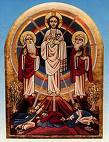Thoughts from Visitation 2: History
One of the more interesting parts of each visitation was discussing with Abbot Anselm the community's recent history. This is perhaps too obvious even to mention. I point it out because it is a particular concern of monasteries (in distinction from other religious orders), and may point to a potential contributions of monastic discipline and theology to the larger Church.
History implies the continuity of principal actors and place. In other words, you can't really write a history without some stability, one of the peculiar vows that monks take. I realize that most religious are relatively stable: we associate Mother Theresa with Calcutta and her houses there. All religious houses have a history. But the history of a monastery is woven especially thick because the main actors almost never leave except by dying. What's more, and this is very important, the superior is also always on site. Monasteries tend to refer to eras by the abbot of the time. "Back in Abbot Upson's time," was frequently heard at Prinknash Abbey.
At Prinknash, we happened to be there the week after the celebration of the 'homecoming' of the monks of Caldey. In 1906, Anglican monks under Abbot Aelred Carlyle reestablished monasticism on the island 350 years after the Reformation. Eventually, a group from Caldey left the Church of England for the Catholic Church and founded Prinknash. Two monks frokm Prinknash went back to Caldey to celebrate one hundred years' time from the refounding of the abbey there. Understanding even this relatively far-off history helps to explain present circumstances in the house. It also encourages a stability of identity for the monks, and monks therefore are well-placed to continue the 'return to the sources' encouraged by Vatican II.
Farnborough, as I've stated in past posts, was founded by the empress Eugenie of the Napolean family. While the present monastery was founded by Prinknash, they moved into buildings put there by the French. Little wonder that there is a certain drift toward Solesmes-style practice in their house.
Another crucial detail in the history of Farnborough is that the year after their foundation, Prinknash, which was literally bursting with monks, founded the Abbey of Pluscarden in Scotland. Why is this crucial? A foundation is very much dependent on its founding abbey, and two concurrent foundations from Prinknash strained both to a certain extent. For a variety of reasons (probably more than those of which I am aware), Farnborough drifted further away from its English identity. At the blessing of Abbot Cuthbert, the gospel was read in French, and the abbot himself gave many of his remarks in French.
How is this helpful for the broader Church? I am convinced that though there has been a ressourcement in the Church, with a return to Patristics rather than a medieval theology, this hasn't yet gone quite far enough. One of the hallmarks of Thomistic philosophy, I think one can fairly say, is that it is interested more in 'essence': static categories of existence and the precise meaning of divine precepts. When he encounters someone in error, the Thomist is perhaps more likely to state the fact simply and propose a remedy. If this can't be done reasonably in charity, there can be a search for a hidden root to the error. On the other hand, I do believe that the Fathers, living at a time of flux and influenced by different philosophical strains, paid more attention to dynamics (not nearly as much as we do in the past two centuries). The monastic Desert Fathers, concerned especially with a variety of individuals, tended to adjust expectations and precepts depending on personal history. The general situation was that monks slept on the ground, but Abba Arsenius was allowed a mat because he was coming from a life of luxury in Rome and was too weak to make that particular ascetic leap. Evagrius was harshly rebuked at a community meeting because he still carried the pride of being a top theologian at court in Constaninople. And so on.
Many of the schisms in the Church today have important historical roots that in general discourse get ignored. How often do we find zealous Catholics attacking Protestant theologies with the assumption that they are held for no good reason, totally ignoring the real problems and abuses that took place in the Church in the 15th and 16th centuries? Sola Scriptura may be annoying to those who love Church Tradition, but there is such a thing as arbitrary abuse of ecclesiactical power! Pope Benedict and Vatican II have both stressed that the Church always stands responsible to the Word of God. On the other hand, how often do Protestants and Orthodox dismiss Catholic practices without any examination of their historical development? In this area, I believe we are especially blessed to have a Pope schooled in a Patristic mode of thought. He is quite attentive to these historical dimensions.
I hope that monks can also set a good example in this area, since it is an area in which we have regular experience. Sometimes newcomers to the life are disappointed at what they believe is flagging zeal in the monastery when what they are really encountering is a spirituality that knows how to deal with the broken histories of each brother, how to reconcile at deep levels by sharing the stories of our lives, merging them with one another and with the story of the community as a whole.

No comments:
Post a Comment